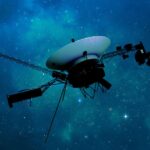In 2022, astronomers reached a historic milestone with the Event Horizon Telescope (EHT) capturing what was thought to be the first image of the supermassive black hole at the center of our galaxy, Sagittarius A* (Sgr A*). But recent findings suggest that the ring-like image may not be an exact representation, raising intriguing questions about what this massive cosmic entity truly looks like.
What Does the Milky Way’s Black Hole Look Like?
Since Sgr A* resides about 26,000 light-years away, capturing a detailed image is no easy feat. The black hole’s gravitational pull is so immense that light cannot escape its grasp, and the surrounding materials move at speeds close to that of light.
EHT scientists faced numerous obstacles when imaging Sgr A*, including the rapid motion of materials around it. Unlike the larger M87* black hole, Sgr A* has less mass, making it much more challenging to capture in a still frame.
The First Black Hole Image, A Groundbreaking Achievement
In 2019, EHT made history with the first-ever image of a black hole, located in the distant galaxy M87. This visual triumph confirmed theories of black holes, sparking excitement worldwide. But Sgr A* proved even trickier.
The mass and environment surrounding Sgr A* complicate imaging. While M87* is more massive, allowing for a relatively stable view, Sgr A*’s smaller size and the speed of its orbiting material cause a “fuzziness” in images.
When EHT released the first image of Sgr A*, it appeared as a glowing ring, reminiscent of an orange doughnut. This image represented the black hole’s silhouette, surrounded by intense radio emissions from its accretion disk.
The EHT team combined data from eight telescopes positioned around the world to capture the image of Sgr A*. The image was stitched together from data collected at multiple locations, an innovative yet challenging process.
Is the Image Accurate?
A recent analysis by scientists from Japan’s National Astronomical Observatory (NAOJ) has raised doubts about the accuracy of this image. Researchers now wonder if the iconic ring is entirely accurate.
The NAOJ team points to potential errors in the EHT imaging process. They argue that some features in the ring could be artifacts—essentially, visual distortions resulting from the imaging methods used.
The accretion disk around Sgr A* emits intense radio waves that contribute to the ring-like structure in the image. These radio emissions are produced as the material is heated and accelerated by the black hole’s gravity.
New findings suggest that the eastern side of the ring may appear brighter due to a phenomenon called Doppler boosting, which causes approaching materials to emit brighter signals.
Imaging gaps are another factor potentially distorting the final image. With limited telescopes contributing to the picture, there were inevitable gaps that had to be filled by computer algorithms.
The EHT team used algorithms to estimate missing data and construct the image. But researchers now speculate that these algorithms may have unintentionally influenced the final image’s shape.
Did EHT’s Choice Skew the Result?
Different algorithms can lead to varying interpretations of astronomical data. In this case, certain imaging techniques may have enhanced or altered specific features.
The NAOJ team applied traditional imaging methods to the EHT data, finding discrepancies compared to the EHT’s original result. Their analysis hints that the black hole may appear more elongated.
How the EHT System Works, Very Long Baseline Interferometry
The EHT project relies on a method called Very Long Baseline Interferometry (VLBI), which links telescopes across continents to form one giant, virtual Earth-sized telescope.
VLBI allows astronomers to capture finer details of distant objects by pooling observations from multiple locations. Without it, imaging Sgr A* would be practically impossible.
Katie Bouman, a key EHT scientist, highlighted the data limitations in the imaging process, describing it as “listening to a song from a piano where many of the keys are missing.” This analogy underscores the difficulty in achieving a complete picture with missing data points.
The sparse data meant scientists had to be creative with the information they had, balancing accuracy with the limitations of their tools.
Could Future Technology Solve the Mystery?
Astronomers believe that advancements in telescope technology may allow them to achieve a clearer view of Sgr A* in the coming years.
The EHT team is planning upgrades that could refine the resolution of future black hole images, reducing artifacts and providing a truer depiction.
The EHT consortium has not officially commented on the NAOJ team’s analysis. However, scientists within the field are closely watching for further evidence that could either support or refute these claims.
Could Sgr A*’s image be misleading? With the NAOJ analysis, some astronomers are re-evaluating how well the 2022 image represents reality.
Editor’s Recommendations
- Astounding Discovery! Zombie Star Survives the Supernova Explosion
- Hubble Telescope Captures Breathtaking ‘Stellar Volcano’ Eruption
- 1st Triple Black Hole System Found by Chance, But It Challenges the Coventional Black Hole Formation Theories
- Universe Shakedown: What Really Happens When Black Holes Merge?




